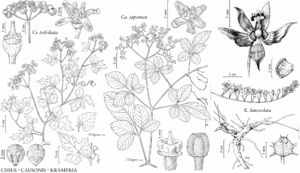Cissus
Sp. Pl. 1: 117. 1753.
| Taxon | Illustrator ⠉ | |
|---|---|---|
 | Cissus trifoliata Causonis japonica Krameria lanceolata | Alice Tangerini Alice Tangerini |
Lianas, climbing by tendrils, synoecious or polygamomonoecious. Branches: bark adherent; pith white, continuous through nodes; tendrils unbranched or 2-branched [3–6-branched], without adhesive discs. Leaves simple or palmately compound [pinnately compound]. Inflorescences bisexual or functionally unisexual, leaf-opposed, corymblike cymes, sometimes compound. Flowers bisexual or unisexual; calyx cupshaped, indistinctly 4-lobed; petals 4, distinct; nectary adnate to base of ovary, cupshaped, entire or 4-lobed; stamens 4; style conic or cylindric, elongate. Berries blue-black to black. Seeds 1 (–4) per fruit. x = 12.
Distribution
North America, Mexico, West Indies, Bermuda, Central America, South America, Asia, Africa, Indian Ocean Islands (Madagascar), Pacific Islands, Australia, mostly tropical and subtropical regions
Discussion
Species ca. 350 (2 in the flora).
Cissus antarctica Ventenat, kangaroo vine, has been reported as escaped in California but probably is not naturalized there. Like C. verticillata, it has simple leaves, but it can be distinguished from that species by having rusty to brown, appressed (versus grayish white, erect) hairs on branchlets and leaves, prominent domatia in the abaxial secondary vein axils (versus no domatia), and dark blue (versus black) fruits.
Selected References
None.
Lower Taxa
Key
| 1 | Leaves simple, blade unlobed, surfaces usually hairy, sometimes glabrous. | Cissus verticillata |
| 1 | Leaves usually 3-foliolate, sometimes simple and blade 3-lobed, rarely unlobed, surfaces glabrous. | Cissus trifoliata |
"connate" is not a number.